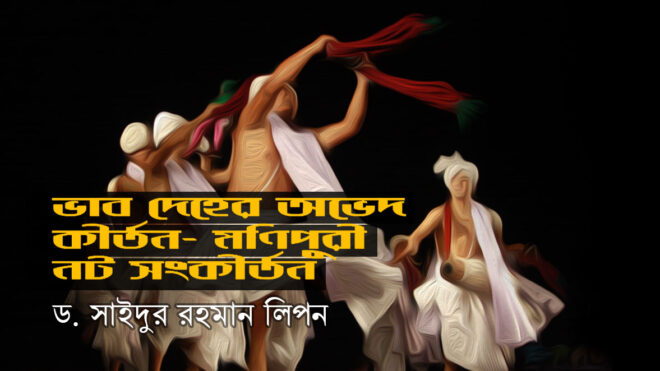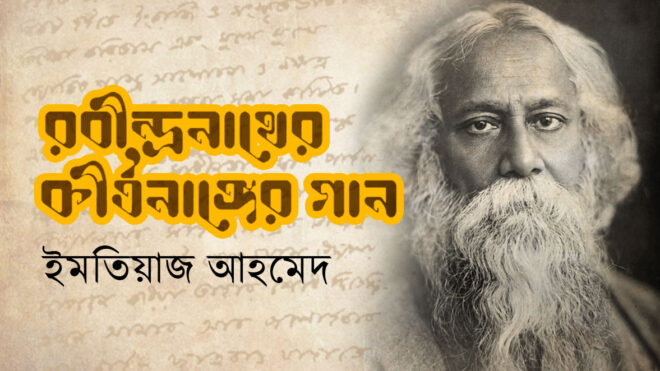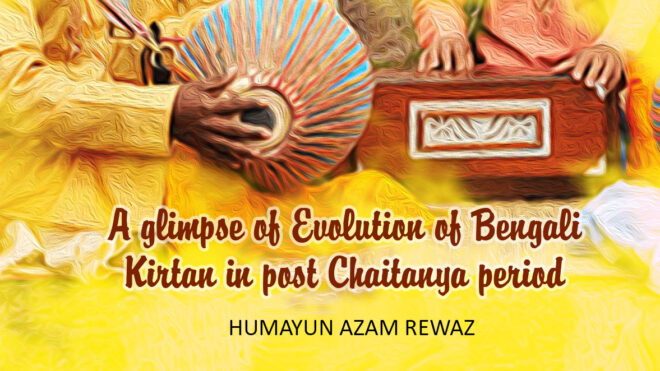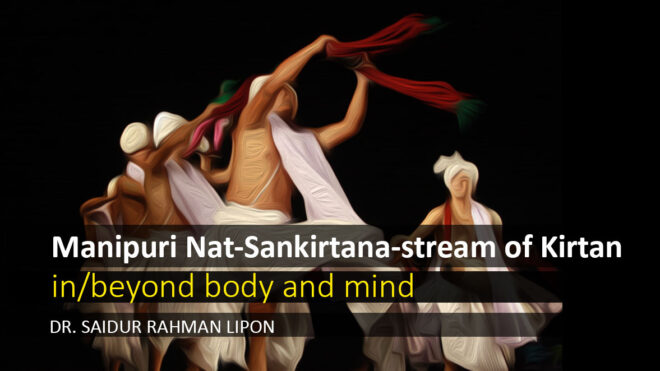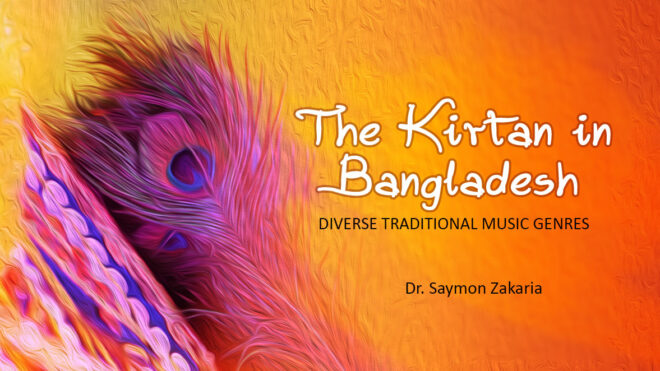Kirtana existed when there was no speech, no language or even no sounds. Kirtana is eternal, the game of immortality, a holy conversation of heart’s longing for union between human and the omnipThis paper analyzes ‘Natapala’, a traditional performance of the Manipuri ethnic culture of Bangladesh. The essay explores how Vaishnavite philosophy, bhava, rasa, bhakti, faith, the roots of the Natapala performance process are operative throught the amalgamation of classical dance styles (Pung Cholam and Kartal Cholam) and the traditional performance styles of Pala performance. It’s an attempt to understand by what techniques and processes Radha and Krishna are embodied in one single non-dual self and body of Kushilab (artist). This essay also attempts to trace how far the roots of the mythological relationship between the Jiva (creatures) and the Supreme are spread in this process of embodiment.otent. Kirtana does not consider words as Hinduwani, Musalmani or Christiani – there is no caste or outcaste in the realm of song, no sect, no religion. It hold the complete historical features of human race in its varied rhythm. Kirtaan does not differ literate and illiterate – all are indifferentiated.
Key Words: Pung-Cholam, Kartal Cholam, Bhava-Deha, Embodiment, Bhakti, Ishalpa, Leela, Assimilation.
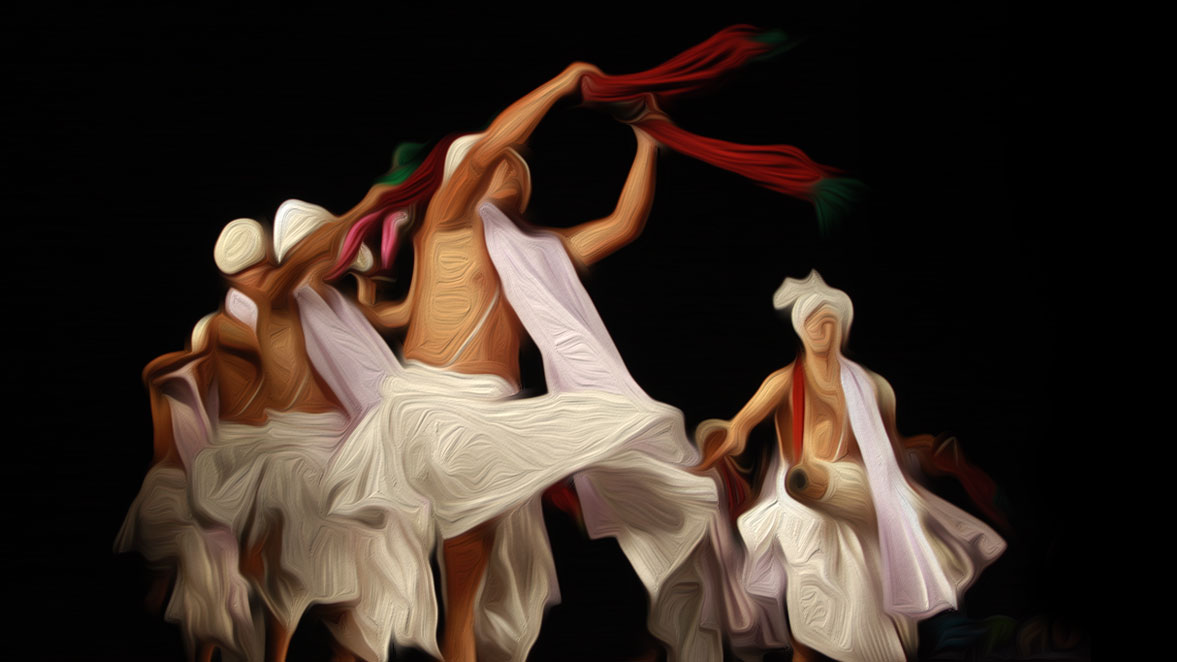
Manipuri Nat Sankirtan in Evolution
A rich performance of the Manipuri (Vishnupriya) cultural heritage of Bangladesh is Nat Sankirtan, popularly known as Natapala. Nat Sankirtan appears as an essential cultural accompaniment of Manipuri society as a ritual to be observed in almost all religious and social functions, from courtyards to crematoriums, temples to temples. These include religious contexts such as Ratha (chariot) Yatra, Holi, Rakhal-Ras, Hari-Shayan, Hari-Utthan, Krishna Janma etc. and social contexts such as Marriage, Annaprashan, Karnavedha, Upanayana, performance of Shraddha etc. Besides, this kirtan also has a special role as a way to fulfill vows. The devotee gets a chance to experience the symbolic experience of virtue by being present or taking a seat in the Punyadham (Mandali/Asar).
Although Natapala is a distinct performance style, the historical link in the origin and development of rasanritya/lila cannot be denied in discussing its ‘evolution’. And at the root of this connection lies the story of Gaudiya Vaishnavism’s journey to Manipur and becoming all-embracing. During various periods in the Middle Ages, there are reports of Chaitanya devotees visiting Manipur. But history says that ‘Gaudian Vaishnavism gained rapid popularity in Manipur through the efforts of Ramnarayan Shiromani’ (Dheeren, 2008. 11). It is said that exposure to the Vaishnavism philosophy of the Bengal region led to a massive change, assimilation and coordination process in the cultural heritage of the Manipuris. The process of coordination is organized mainly around two things, the Vaishnavism philosophy and the local art-style. It is the Vaishnava content which has been super imposed on the existing layers of artistic performance’ (Vatsyayan, 1976. 138). As an inevitable result of this religio-cultural combination, several adopted art forms developed, such as Rasanritya, Khupa-ishei, Sankirtan, Natsankirtan or Natapala etc. This entire process was organized in the late Middle Ages, where newly adopted art practices found their way into specific classical structures and became distinct and personal. Naturally, the religious, social and cultural context of all the other arts and customs that developed along with Nata-Sankirtan also developed in the same historical context. Historical examples show that Natapala or Natsankirtan or Anauba Pala was created during the reign of Maharaja Bhagyachandra (1764). It is also an acknowledged fact that the role of ‘Bangdesh Pala’ or ‘Ariba Pala’ (Darshana Jhaveri and Kalavati Devi, 1993. 15) was special and important in shaping the underlying ideology of both Rasanryta and Natapala. According to the route from Bangladesh, this Bangdesh Pala is called the root or origin of Natapala. It was during this phase of cultural assimilation, i.e. during the period of Maharaja Garib Nawaz, the predecessor of Bhagya Chandra, that Bangdesh Pala was introduced in Manipur.
On the other hand, in spite of specific differences in customs and characteristics, in the rasa festival, Rasanritya and natapala are performed complementary to each other according to the statutory sequence. As because; ‘Natapala is mandatory part as a precursor to any rasa’ (Darshana Jhaveri, Kalavati Devi, 1993, 39). This issue of sequential performance of rasanrita and natapala in the same performance volume or rasa-mandali can also be seen as an attempt to assimilate or integrate one classical art form into another classical art volume. Because the difference in performance or nature of performance is obvious – Rasanritya is performed in the ‘natagita style’ but Natapala is performed in the ‘narrative style’ (explained later). All the performers of Rasanritya are performed by minor teenage girls but Natapala is performed by adult male performers. Oral acting of Nritya-Kushilab (performer) is considered to be of secondary importance in Rasanritya. Characterization is done through angik (dance posture and movement) and aharyavinya. On the contrary, Bachikavinaya and Sattikavinaya are predominant in Natapala. The performers (Radha, Krishna and the Gopis) embody the character’s spirit (explained later) using lyrical and poetic elements to perform the action. Yet two fundamental similarities frame the natapala and rasa dance performed in rasa-mandali into a single and inseparable art form. First, Subject (Radhakrishna) and two, Bhava desire (Krishnabhakti). Bhav and It is almost impossible to establish a symbolic temple. Natapala establishes Krishna-bhavayatana by symbolically installing the idol of Krishna, sitting and donating life by performing rituals like raga-alap, pungcholam, kartal-cholam, gauranga bandana, guru bandana, Vaishnava bandana etc. Then in the established Krishna-bhavayatana, the rasalila or rasa dance is performed in the rasa-mandali filled with devotional passion. Such involvement of Natapala as a ‘precursor’ of Rasa has the potential to be interpreted as a great cultural-cohesion.
[At that time] some Kirtaniyas from Bangladesh came to Manipur. They were very happy to get the temple. They would come to the temple during the evening aarti and sing kirtan. To accompany the kirtan, the king presented a pung or mridanga. This pung was created by combining the khunbung musical instrument used in the royal court and the clay shell of Bengal – a novel invention. The kirtan gathered with the help of Pung. There was also a bell made of iron. Thus a new genre of kirtan arose for the worship of Vishnu (Chaliha, 2009. 39).
So there can be no doubt that Nat Sankirtan and Rasanritya are two complementary yet distinct art forms developed through multi-dimensional cultural exchange and synergy in the same social and religious context. In this case, Nata Sankirtan is an adopted new art form created by the amalgamation of the local arts of Manipur with the Kirtanangik of Bengal. However, this result of assimilation and its process cannot be fully understood if we look at its development and evolution over a period of time. Rather, it is necessary to understand at once the ancient and mythological roots of the doctrine of the separation of nature and the Absolute.
Mythical Roots of Alienation
Lord Krishna is the main deity of Manipuri religious and social culture. Bhakti and love which is the soul or life of worship and active ceremonies or Sankirtan whose body is ‘Sankirtan is the destruction of sin. Chitta Shuddhi Sarvabhakti Sadhana Udgam (Mukhopadhyay, 1990). Nevertheless, the form of social and religious culture of the Manipuri people as observed today is deeply rooted in the combination of three religious traditions and rules. Manipuris mainly follow Vaishnava religion. Many of these are ancient ‘Apokpa panthi’ who did not accept Ramanandi Vaishnavism preached by Shantidas Goswami during the reign of KIng Garib Nawaz. However, despite the differences, the Vishnupriyas are all Vaishnavas by religion. Although the form or ideology of Manipuri Vaishnavaism is not quite clear, the influence of Sri Chaitanya’s Vaishnava-ideology began to be clearly manifested in the beginning of the eighteenth century (Ahmed, 2011). Therefore, there is no opportunity to consider ‘religion’ theory and philosophy in the discussion of Bangladesh’s Manipuri ethnic knots as secondary importance, rather it can be said that this special performance is deeply rooted in the religion-theory, philosophy and practical rituals of this people. Important differences are distictive between Eastern and Western art theory and philosophy.
Ever since man regarded the body as the image of the universal Brahman and realized within the body the Creator and his creation, or found the Creator as a bird (soul) caged in his own body, perhaps Indians learned to think of the body as an essential precondition for transforming the body into immaterial expression (vatsayana)., 1995). And it may not be possible to determine exactly when this thought started in the human mind, but the eyes of the Vedas, Upanishads, Puranic poets have not made a mistake in relating this thought to the human mind.
The Vedic writer is fully conscious of the physical reality of biological man. […] Narayana, who is also the author of the Purusa-sukta (R.V.X. 90) describes vividly the organs, limbs, and parts such as the skeleton, bones, muscles, veins and arteries of the body on the cosmological plane. […] He created the earth and the bodies. […] The moon was born from His mind, the sun from His eyes, from His mouth, Indra and fire, and from His breath was wind-born, the heaven, the earth from His feet, the four quarters from His ear –thus they fashioned the worlds (Vatsyayan,1983).
Elsewhere in some hymns of the Rigveda the Supreme Personality of Godhead is himself imagined as a brahma-pillar. Several hymns in the Rigveda are devoted to the Stambha or the Skambha where the Supreme Being itself is seen as a great Cosmic Pilar (Vatsyayan, 1983). But who is this Parampurusha in the image of Brahmastambha? What is the explanation? In answer to this, the Atharvaveda explains the anatomy of the Brahmastambha as a symbolic structure of the body.
Chapter X of the Atharvaveda says: ‘(7) What is above, below and in the middle, that which the creator created as the universe, to what extent did this Pillar enter therein? The portion (of it) that did not enter, how much was that? (11) In which penance asserting itself, maintains the higher vow, wherein are the moral order and faith, the waters and the knowledge, tell (me) about that Pillar, who ‘is He?’ And again, ‘(32) Obeisance unto that supreme Brahman of whom earth is the footstool, the ether is the belly, and who made heaven His head. (38) The mighty adorable spirit at the centre of the world, engrossed in penance on the surface of water, on Him rest all the gods that are, even as branches round the trunk of a tree (Vatsyayan, 1983).
According to this description of the Atharvaveda, Brahma or Brahmastambha (Cosmic Pillar) The middle layer—space (the ether is the belly) the center (Central Pillar) connects the sky (Sky) and the earth(earth), which is simultaneously symbolized as the three layers of the full form (sthamba) of the Supreme Personality of Godhead Brahma, where or Kendra stomach connects the feet to the earth and the sky to the head. Naturally at the intermediate level there will be a center or point, which is described in the Vedas as the navel (hadhavasha) of the body. As a result, the center of the body, the navel, is the middle part of the column with the upper part of the body; it is described as the connection-point of Nikhil with the body or the Absolute with the living being. ÔAgain many hymns of the Vedas mention a centre which corresponds to the navel of the body. Thus, repeatedly we are told in these cosmological hymns that the stambha or the great pillar is located in the middle or the navel of the earth (Vatsyayan, 1983).
The idea of symbolizing various organs, forms and expressions by adding the body to the material and non-sensuous totality of the universe is not only explained in the Vedas, but the Upanishads also add the body to the structure of the expressive expression (physical and mental) of the immaterial Absolute. The Aitarya Aranyakas describe the origin of living beings (manava) and the world and their qualities in one sutra–that this Brahman originally existed only in the form of self or soul (nagvashava) and from the soul the human race was formed.
The Aitareya Upanishad II.4.1 […] in the beginning there was the self who created the waters, from which he created the Primordial Man, from whose mouth, speech, nose, smell, eye, ear, heart, mind, navel and the generative organ subsequently emerged; how from these limbs and the sense organs were first created the divinities Fire, Vayu, Aditya, Quarters, Moon, Death, Waters, etc and then divinity man; how fire (agni) entered in the form of speech, air (vayu) in the form of breath, the sun (aditya) in the form of the eye, quarters (disa) in the form of the ear, the moon in the form of the mind, and how finally the highest self-entered him (Vatsyayan,1983).
The creation, division and symbolization of body (Sarapatparadanga) is for the sake of attaining the knowledge of Brahman (Sadhapataparadanga) who is the soul, ‘Who am I?’ This body is not me. The body is mortal. The soul is immortal. The Upanishads teach us the answer to this self. I need to know the inner me. This knowledge that soul and soul are identical is “self-knowledge” (Bhattacharya, 2012). If self-knowledge or self-knowledge in such undifferentiated consideration lies in the secret of salvation, then this non-dual concept of body and soul is not only the truth of the Vedic Upanishads or the Puranic age. This is the truth of Eastern-Prakrit Yuga, Paramastya Vaishnavas too. Generally speaking, Shiva of Vaishnava Krishna Shakta, Purusha of Sankhya, Bodhichitta of Vajrayani, Karuna of Sahajani, Kalachakra of Kalachakrajani; And Radha is the power of Shakta, the nature of Sankhya, the loose soul of Vajrayani, the emptiness of Sahajani, the wisdom of Kalachakrajani. Vaishnavism is also touched by this spirit of contemporary times, it is not strange. There is no doubt that Krishna-Radha belongs to the Purush Prakriti and Shiva-Shakti meditation family of the later Sahajiya Vaishnavism (Ray, 1356).
The eternal tendency to search the body in search of the Absolute, or to search within the body for the movement and change of Brahma, was not only confined to the works of philosophy, poetry and literature (Vedic to Prakrit), but man has been an integral part of all ages. -Also tried to express it in practical terms with equal interest. Shastrakars have therefore explained the world-wide phenomenon (nhravatngdhsa dhayabhadsabhaha) in one and the same bond, inter-connection and dependence of the outer body form and the soul-like inner through various visual poetry or dance. He wanted to get the ultimate taste not in the long-traveled Vrindavan, but in his own body-Vrindavan. If this is the essence of self-realization, then why would dramatists stay away from this pursuit; The undifferentiated pursuit of soul-soul is symbolized by body and mind in order to search for the meaning and reason of human life, respectively the theatrical bodyÑ itivarta (structure/arrangement/plot) and the theatrical soulÑ rasa (the ultimate joy/enjoyment/experience of the performer, audience and listener) respectively. In practical sense/expression consonanceThe relationship of the one and the many, the inner and the outer, the structure of multi-layering are the guiding principles of the rasa (atma) and itivrtta (sarira)(Vatsyayan,1983).
Hence the non-dual non-differentiating presence of body and mind (atma), which has been symbolized in many different names and forms throughout the ages—sometimes as symbols of Jivatma-Paramatma or Purusha and Prakriti and sometimes as Ardhanarishwar or Radhakrishna. Greater medieval Bengal was inundated by Vaishnava philosophy, an artistic consciousness developed in this mythic and practical tradition of the undifferentiated relationship of identical body and soul or Dehpî-Bishva-Brahma. Neighboring Assam, Tripura and even Manipur are not spared from this flood. Manipuri Nat Sankirtan is a new art form resulting from this Vaishnava cultural inundation.
Structure
The Nata Sankirtan performance of the Manipuri (Vishnupriya) community of Kamalganj, Srimangal is descriptive. However, the narrative of this Natapala follows the three-character style of Srikrishnakirtan by the popular medieval dramatist Lipi Bara-Chaidasa (1370-1433). However, this kirtan did not follow the Natagita style. Rather, its narrative follows the style and features of the narrative performance of the kirtan form developed in the medieval ‘kathanatya’ genre. Although dialogic participation is present, the main tone of narrative presentation is narrative. However, this Sankirtan is an essential part of Manipuri’s religious and social rituals, but its structure and presentation follow the rules and order prescribed by the Shastras. The kirtan, structured in a combination of two different performance styles, consists of classical dance performances – Pung Cholam, Kartal Cholam and narrative performance of Krishna Leela in lyric poetry and dialogue. Natapala’s Krishna narrative is presented in the combination and arrangement of these two self-characteristic art-styles.
Eastern color
Brahmin parva: The stage where sankirtan is performed is symbolically regarded as Vrindavandham. Brahmin Thakur purified Vrindavandham by chanting his mantras. After purification begins Nata Sankirtan, the sequence of which is as follows:
Gourachandra: Gourachandra means worshiping Gauranga. Gauranga is sought as the representative of living beings. Gourachandrika begins with Raga. The raga is of nava akshara Ñ re ta na re ta na ta na Ñ this raga means idolatry. Idolatry is established through anger.
Berighatu (Parikramana): Being sheltered by the Guru in Asare ‘Vande Shriguru’s footsteps, gentle mother Shikshaguru’, saying this the Guru is sheltered.
Avatar: A performance of songs about Gauranga Mahaprabhu’s Avatar. Gauranga who owes love to Radha. This debt is three senses, luster and luxury. He (Krishna) came to earth as Gauranga Avatar to pay off the three debts. Radha’s intense desire/desire to attain Krishna is ‘bhava’. Krishna’s intense longing to see the form of Radha while milking the cow is the ‘Kanti’. And ‘luxury’ is the love of Radha-Krishna with hundreds of Braja-gopis in Rasalila of Vrindavan.
Tin Tali or Tin Tal: The song performed to fulfill the three banchas (Bhav, Kanti and Vilas) is called Tin Tal.
Milon (concurrence): Ananda Milon with Bhakta. Purnarupa of Gauranga Mahaprabhu – holding the idol and performing the Leela to share His pleasure with the devotee – this is Mel.
Mlivichar: Panchatatta Nityananda’s (elder brother of Gauranga) Bhava to hold the session.
All these spiritual ceremonies culminated in the pre-performance part of the Natapala. According to the classical doctrine, the Purbaraag of Natapala can also be interpreted as the preparation-ranga for the kirtan of the supreme union with the living being. This preparatory phase of Maha-Milan (grand union) is not only in recitation of scriptures, not only in spoken words, but in the tumultuous invocation of songs, poetry, melody, rhythm, rhythm and dance rhythm, and then Krishna himself is seated in the hall. Stand face to face with the devotee, fulfill your desire, and enjoy Krishna’s majesty. It can be said that all these ceremonial rituals of the Purranga make the worship of the deity in the Asar definitely possible for the devotee’s feelings and beliefs. Because The cosmology given in the Purana is the devotiee‟s experience of the outer universe, which is interiorized in the text of the hymn. Thus, the hymn is an integral part of the Puranic (mythical) narrative and not extraneous to it at all. The Kirtana is therefore functional in the specific context of the narrative. The Purana is Kirtana writ large (Paniker, 2003. 37).
Narrative episode
Radhakrishna’s Lilamaya Akhyan or Pala is performed at the end of Purbaraga ceremony. The Natapala in question is analyzed on the basis of observing the Leelas of the four hours of the day, i.e. dawn, morning, midday and afternoon. Following is the summary of four hours of Krishna Leela:
Pratah (dawn hours) : “In the early morning Nandarani Krishna wakes up, Uti Krishna Pratakhrit Shubh Samadhila\ With friends playing in the house Arambhil, Gopala Heriya Rani Amayat Bhel\” Krishna’s morning pastimes are described in this hour. Pratah Rasa mainly manifests Vatsalya love. All Krishna’s pastimes with the mother are settled amicably.
Morning: Goshta Lila. The story of Krishna’s acceptance of his mother’s permission to graze the cows in the forest at the request of Krishna. Through the intercession of his brother Balarama, Mother finally gave Krishna permission to graze the cows. This part of Leela is settled amicably.
Midday: “Dear Sakhi Lalite, double fire over fire friend Premanale\Krishna Premanle Shyam Premanal’s J¦ala, Preya Sakhi Lalite\” The Lilamay narrative of Radha Krishna’s couple-meeting in forest pleasures and aspiration is narrated in this episode. The sweet mood is resolved in this episode’s Lilakhana.
Afternoon: Time to go home. “Bhojan shayan sari, pasha krira sukhsari\ At the end of the day in the afternoon, Krishna goshta parveshe\” At the end of Surya Puja at Gotasthan, eat Prasad, prepare to go home. At the end of Banvilas, “Here is Radha with Sakhi, Aila Apan Grihe. I give gifts, but I wear many clothes, I climb the building, Krishna went to my house, but I gather God, I come home with my friends. Yasmati Krishna Paya, Chand Mukhi Nirikhiya Nishiya Lail Ramakanun\” The eloquence of this episode is settled. After that, Radhakrishna’s Lilamaya narrative of the four hours of the day ended.
At the end of the narrative, there is also a performance of the mridanga and the tumal dance of the mridanga and the cymbals, the phagukhela, the narration of results, etc.
Nata Sankirtan in learning
As mentioned earlier, Manipuri Natapala is a fusion of two art forms. On one side of these art forms is the classical cholom or dance. Cholam or narttan again has two forms namely poongcholam and kartal-cholam. These two classical choloms/dances are performed to the accompaniment of raga, taal, melody and rhythm by a group of skilled musicians. And on the other hand, there are traditional gayen/ishalpa, associate gayen and dohar. They perform the Krishna narrative in a descriptive manner.
Pungcholam is a special dance performed by pung-players to the beat of pung or mridanga and kartal-cholam is a cymbal performance performed to the dance of kartal players. There are certain provisions in the body posture, movement and movement displayed in these two choloms or dances. In accordance with the rules prescribed by the Shastras, the well-arranged and structured poongcholam and kartal-cholam are then displayed in the dance itself. Students/pupils acquire practical skills in both these dances under the direct supervision of the Guru and through a long training process. Note that Gayen and Dohar do not participate in Pungcholam and Kartal-Cholam or Narttan. Similarly the poongcholam and kartal-cholam are not displayed except for the prescribed part of purvaranga and narrative.
Although Pungcholam and Kartal-cholam are structured by certain postures, movements and movements, the basic posture of the performer-body in both dances is almost the same. In this posture, walk in an English ‘V’ shape with the ankles slightly apart, the spine straight but slightly bent forward. At the beginning of the Cholom, the initial body-rhythm of the Kushilabs becomes a gentle sway to the rhythm of the combination of mridanga and kartal. Alternately changing the weight on the right leg to the right side and the left leg to the left, thus swinging the whole body from right to left. After that, other postures and movements are gradually applied in the body movement according to the rules of raga, taal and loye.
Four types of postures and movements are observed in the dances of Pung and Kartal players. One. finger step of the right foot respectively in curved knees. Two. Right foot forward step arrival and back-step to the previous position playing the instrument in walking motion, three. Alternately playing the instrument in a clockwise and counterclockwise rotation while maintaining weight and balance on both feet, and four. Perform instrumental and dance performance with one leg bent at the knee and the other leg bent at a ninety-degree angle above the ground while keeping the body in motion. However, an additional posture is observed in the movement of the cymbal-cholam, keeping the mass and balance on one leg and keeping the other leg bent at a ninety-degree angle to zero, demonstrating cymbal playing in rotational motion.
In Manipuri dance texts, the postures and movements of poongcholam and kartal-cholam are symbolized by different names. For example, the standing posture of Kushilab is called ‘Sthanaka’ or ‘Firek’ and three types of postures have been mentioned in the case of Punchalom. These are one. Thongkhong Awangba should be kept with a wide gap between the ankles and the south i.e. the right leg should be slightly lowered in the trident position. Two. Thongkhong Mayay – bending down so that the wrists of both hands can be placed on both legs with more space between the legs. And three. Thongkhong Anemba – bending down with such a gap between the legs that the elbows touch the knees.
Just as the pose of the poongcholam and kartal-cholam is fixed, so are the rhythms and ragas of the instrument. Eg: Nata-raga is ‘Bol’ based narrative. By this, the Krishna statue in the temple is given the symbolic life. Tintal – eight varnakala or seven varnakala momemnt. The three claps or taals are performed to fulfill the three wishes that the song calls the three taals; Rajmel seven/fourteen scale rhythms etc. are used.
Bhava-deha(body and soul) kirtan
While the dance-rhythms of Natapala’s Gayan or Ishalpa and allied Gayans do not employ classical Cholam or Narttana, the scriptural rule is evident in the rendering of the characters (Radha, Krishna, Sakha/Sakhi). And this is what makes Natapala’s acting so special. Ishalpa’s body-canvas does not feature Radha and Krishna in any particular anthropomorphism or posture in character construction and morphing. Although the mythic and traditional images of Radha-Krishna’s dual form, such as ‘Krishna with flute’, ‘Dual image of Radha-Krishna’, ‘Balak Krishna’ etc., some popular images are embodied in body language sometimes. Yet the fundamental tendency of Natapala Gayen (the singer), embodiment of Radha and Krishna is not presented in any specific bodily language or posture, but in expression of expression or expression. That is, Radha-Krishna is embodied not in the form of body, but in the form of expression or in the form of expression in the sway of soft valor and rhythm in the canvas of the body. As a result, Gayen’s body form and posture as a whole are expressive, devoted to Lord Krishna and full of devotion.
This matter of embodiment by inner thought can be seen as a process. The basis of which is the Vaishnava philosophy and the analytical approach of Kusilavas (performers) of Natapala. Because the purpose of Natapala is to spread the greatness of Krishna among the devotees, which is inflamed with holy and ecstatic passion, yet humble in devotion. Even though the imagery of some part of Pungcholam and Kartal-cholam is like a storm, it is so delightful storm to the Gayen ‘lasyamay-tava’ (Das, 2015). Ultimately, the perpetual posture of Gayen’s physical presence in the Natapala Asara is transformed into a vibrant rhythmic body full of devotional feelings swaying with soft rhythms. This is the blessings transferred from the Guru. By means of those blessings the legacy is potrayed here (asare). Everything is captured in a way, standing on the inner feeling, the feeling comes in their (Kushilab) body, tone, rhythm and is transmitted to our (audience/devotee) body (Singh R.G., 2015).
Such omnipresent and all-embracing expression of the narrative in Natapala Asara is also a matter of the teaching process. Which is traditionally transmitted from generation to generation in the form of ‘perfoming knowledge’ through the understanding of guru-disciples. In this teaching process Krishna Himself is a ‘bhava’, which is studied and manifested as ‘Krishna-bhava’. Because in Vaishnava philosophy, the permanence of Sringara (copulation) is Krishnarati. Bhakti(devotion) is what makes the copulation sublime is rasa’. Happiness is in the taste of that devotion. Ananda(happiness) is Brahma’ (Mukhopadhyay, 1990, 52). Bhakti rasa is explained in Ujjalanilmani written by Srirupagoswami- (Signs of sublime devotion prevails where…). If the vibhava, anubhava, sattika and sanchari can be enjoyed through consequence of pursuit that can named as sweetest wine of devotion asserted by the saints.
The reason for the enjoyment of the Copulation (Rati) is called Bibhava. There are two types of these changes: dependent (salamban) and enthusiasm (uddipan). That enthusiasm is again of two types, Krishna and Bhakta, i.e. Krishna related enthusiasm and Bhakta related enthusiasm (Rupgoswami, 1341 Bangabda, 5).
From this provision of the scriptures, it is clear that the main way of attaining Brahmananda is not by the construction of special forms or postures of the body, but by the innate feeling of the being or the enjoyment of Madhurakhya Bhakti by sattika-related actions. Therefore, the incarnation of Radha or Krishna becomes an expression rather than a specific body posture or movement. As a result, Radhakrishna is embodied as a non-dual form in the body of the body; in a particular sense-form, yes, but not in a human-body form.
The incarnation of Radhakrishna in the spirit-body is accomplished in a specific process. The process is creative, beginning with the Gaurachandrika portion of Purvaranga (discussed earlier). It is from this part that the symbolic image of Krishna is constructed with the help of classical ragas and rhythms anger is the soul. At the beginning of Gaurachandrika a raga is sung or to begin with the raga. This raga is of nine letters Ñ ta, re, ta, na, re, ta, na, ta, na. The idols are potrayed on soundscape through this Raga. Each letter has a different meaning/connoation, through which the image is represented, i.e. hands, feet, head and all the body parts of the Creator are created or shaped. Every organ/appendage of the body is determined by that Raga-Tal-Bole mantra. When the raga was over, the complete murti (idol) was potrayed, i.e. the image of God/Gauranga/Krishna was formed in the imagination. This is called Raga-idolatry (Singh, 2015).
The act of setting up idols in raga-alapa is symbolic. It is through this process that the incarnations of Gods Brahma, Vishnu, Krishna, Gauranga are possessed or embodied in the mind-body of mortal man. The process can be interpreted on the one hand as a symbolic union of nature and the Absolute. Because through this process the devotees relish the experience of symbolic union with the Absolute. On the other hand, it is in this process of embodiment that Gayen/Dohar renders Krishna’s imagined Bhava-Akriti or Bhava-Deha in body language with gentle rhythms of devotion. As a result, the construction of the image of Radha-Krishna in this process is not based on strategic external behavior or posture. Even in the vocal embellishments of the Gayen, the characters of Radha and Krishna are not constructed/displayed as separate and distinct models. As a result, in this overall process of idol building, Gayen imposes on his body an evocative persona of the everyday-extraordinary, or Gayen is able to impose on himself, which soon gains acceptance among devotees as the most sacred and venerable figure. Which is clearly reflected in the reaction of the devotees at Natapala’s event. At this time some of the devotees considered Gayen to be an avatar of Gauranga. In the pursuit of emotion, one bows down to Gauranga. A little bit of blessing is blessed and the head is lowered in front of that gayen. On the other hand, the understanding of the Gayans of Natapala about this process of making idols is that ‘Gaur Gurumurti is made completely inside the body by means of the musical instrument Mridanga-Kartal. This idol does this sankirtan within us.’
Hence Natapala Gaya Himself appeared before the devotees as a Supreme Personality incarnated as the identical soul of Radhakrishna. How deep the importance and significance of Bhava in Natapala’s performance becomes clearer through the following interview. During the field-survey, excerpts from the conversation of Rasdhari Gopimohan Singh, recorded in the context of Natapala, were quoted.
Question: What is the idea of longing(bhava)?
Answer: Radha being the wife of Ayan Ghos, even from Ayan Ghos’s house, only desire that when I will get Krishna. This is the meaning of Radha’s intense desire to gain Krishna. That is, the intense desire to see Krishna is Bhava or Krishna-bhava.
Question: Where did Radha originate?
Answer: Radha originates from the permanent form of Krishna. Radha-Krishna Ekatma, just because of Leela, because of teaching us their different forms.
Question: Which Bhava predominates, Radha-bhava or Krishna-bhava?
Answer: I have only one thought, Radha-Krishna is not different to me, S/He is one soul.
Question: How can you be so busy?
Answer: You have to practice a lot, that is, you have to study in Gurugriha. It should be done according to the rules of the community, regardless of the community. After mastering the secret teachings from the Guru and then not giving trials on his own, or he must always be in Sadhana.
Question: Before appearing in Asar, you were a very simple and calm person. But if you stand in the hall, a special energy stimulates your body, why?
Answer: This is the idea, that our sadhana or bhajan, to attain nearness to the Creator, which is the best way, there are different ways, according to our Vaishnavism – this is our Ashtaka, what we have described here (observed natapala) is four kaal. This Ashtakala is the path of our main Sadhana. And there is our main idea – I did not say pure love. If one can go that way, then his heart will melt, then he will be able to enter the main sadhana organ. This is our Guru’s teaching that by following this path one can attain closeness to the Creator (Singh R.G., 2015).
From the quoted interview, it is clear that ‘bhava’ is the vitality of Natapala which spreads the rasadhara of Krishna-bhakti among the devotees from asar to asar. But it is not the case that the Kusilavas merely indulge in the rasadhara of Krsna-bhakti and indulge themselves in uncontrollable emotions. Classical ragas, rhythms, tones, rhythms and stylized movement of the body, movements and postures make the emotion controlled, dedicated and above all artistic. Thus the overall art structure of Natapala becomes a linked and integrated art form of two types of performance – classical dance-style (Pung Cholam and Kartal Cholam) and Krishna-narrative exposition in classical mood and devotion. It is in such a joint representation that Radha and Krishna are embodied in one body, one and the same soul. So the ‘bhav-deha murtkaran’ or ‘imaginary embodiment of Krishna-bhava’ of the identical Radha-Krishna through humble devotional offering, not as separate forms, becomes the ultimate goal of this kirtan performance.
From this overall discussion, three characteristics of Nata Sankirtan can be identified. In this kirtan Sri Gauranga is the twin incarnation of Radha-Krishna as one and the same soul. Two. The process of sculpting the ragalap in Purvaranga Gaurachandrika is symbolic, which does not construct a physical model of the character. Bhava embodies Krishna’s imaginary body. Three. The purvaraga, akhya-antha parva and certain parts of the performed narrative where classical dance is applied, are performed only by poong-baadak and kartal-baadak. In contrast, the body dance of the singer and co-singer in the narrative gitabhina is merely a rhythmic movement of the body or a swaying of the body. And thus, inspired by a mythological ideal and non-differentiation, the Kirtaniyas established another body in the heart of the devotee with absolute trust and true faith, the non-different Radha-Krishna’s spirit-body.
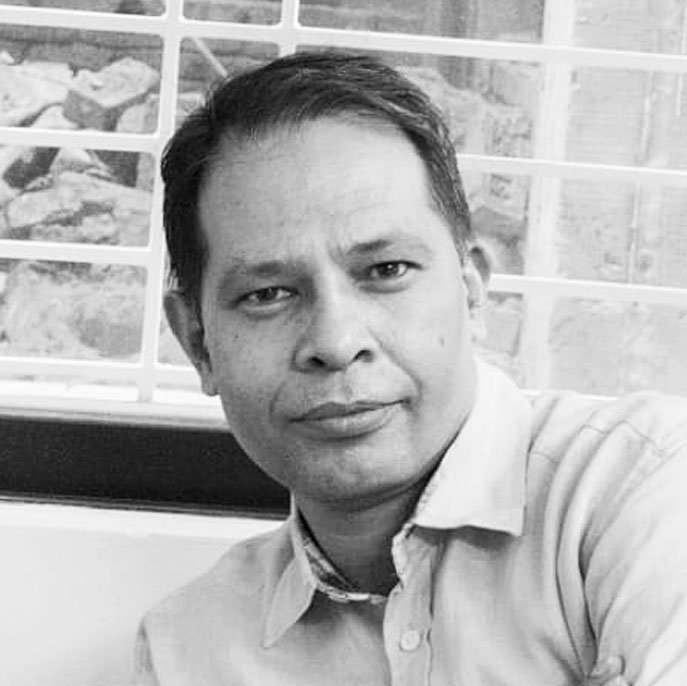
Information of Author
dr. Saidur Rahman Lipon
Author and Researcher
Citation
- Ahmed, Syed. Jamil. (2000). Acinpakhi Infinity: Indigenous Theatre of Bangladesh. Dhaka: UPL
- Paniker, K. Ayyappa. (2003) Indian Narratology. New Delhi:Indira Gandhi National Center for the Arts
- Vatsyayan, Kapila. (1976). Traditions of Indian Folk Dance. Delhi: Clarion Books
- Vatsyayan, Kapila. (1983). The Square and the Circle of the Indian Arts. New Delhi:Roli Books International.
- Mukhopadhyay, Harekrishna. (1990), Bangalar Kirtan O Kirtaniya , Kolkata: Pashchimbanga Rajjo Pustok Parshad
- Ahmed ,Afser(2011), Chad noy Radha Neme Esechilo. Moharaas Purni,ar Asare, Shuvashis Sinha(Editor) , Manipuri Thetare Journal, Raas Leela Issue
- বাৎসায়ন,কপিলা. (১৯৯৫). ভারতের-নাট্য ঐতিহ্য. ইন্ডিয়া: ন্যাশনাল বুক ট্রাস্ট
- চলিহা, দেবযানী. (২০০৯). মণিপুরী নৃত্যের দুটি ধারা. ওহ ম. মজিদ (সম্পাদিত), আদিবাসী সংস্কৃতি. ঢাকা: মাওলা ব্রাদার্স
- দর্শনা ঝাভেরী, কলাবতী দেবী.(১৯৯৩). শাস্ত্রীয় মণিপুরী নর্ত্তনালয়. কলকাতা: মণিপুরী নর্ত্তনালয়
- দীন, সেলিম. আল. (১৯৯৮). বাঙলা নাট্যকোষ.ঢাকা: তরফদার প্রকাশনী
- ধীরেন, থ. (২০০৮). বাংলাদেশের মণিপুরী জাতি. সিলেট: মণিপুরী এথনিক কমিউনিটি ডেভেলপমেন্ট অর্গানাইজেশন
- মুখোপাধ্যায়, হরেকৃষ্ণ. (১৯৯০). বাঙ্গালার কীর্তন ও কীর্তনীয়া. কলিকাতা: পশ্চিবঙ্গ রাজ্য পুস্তকপর্ষদ
- রূপগোস্বামী, শ্রী. (১৩৪১ বঙ্গাব্দ). উজ্জ্বলনীলমণি (সম্পাদিত, চতুর্থ সংস্করণ). মুর্শিদাবাদ: শ্রী ব্রজনাথমিশ্রেণাস্য
- সিংহ, বিধান. (২০১৫, জুলাই ১২). রাসনৃত্য. (স. র. লিপন, সাক্ষাৎকার) কমলগঞ্জ
- সিংহ, রাসধারী. গোপীমোহন. (২০১৫, জুলাই ১০). রাসনৃত্য. (স. র. লিপন, সাক্ষাৎকার) কমলগঞ্জ
- হালদার, গোপাল. (১৯৭৪). বাঙলা সাহিত্যের রূপরেখা. ঢাকা: মুক্তধারা
- দাস, সুইটি. (২০১৫, জানুয়ারী ৬). রাসনৃত্য. (স. র. লিপন, সাক্ষাকৎকার). সাধনা, বনানী, ঢাকা
- ভট্টাচার্য্য, প্রদ্যোৎ. (২০১২). ভারতীয় দর্শনের রূপরেখা, ঢাকা: রোদেলা
- রায়, নীহাররঞ্জন. ( ১৩৫৬). বাঙ্গালীর ইতিহাস : আদিপর্ব, কলকাতা: দে’জ পাবলিশিং
